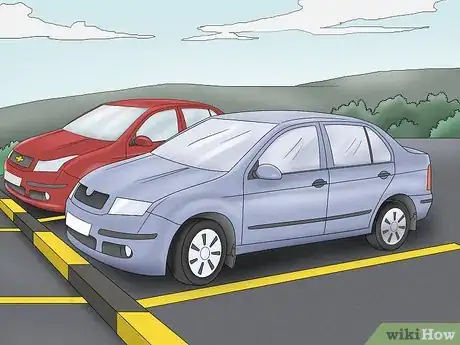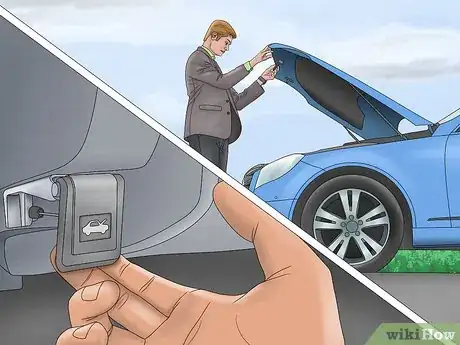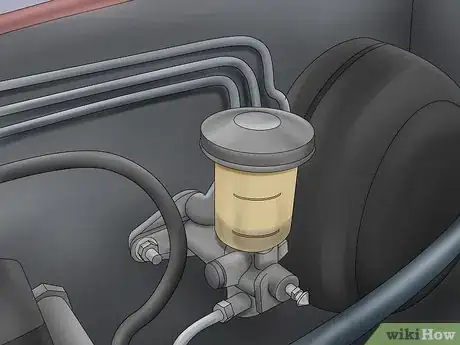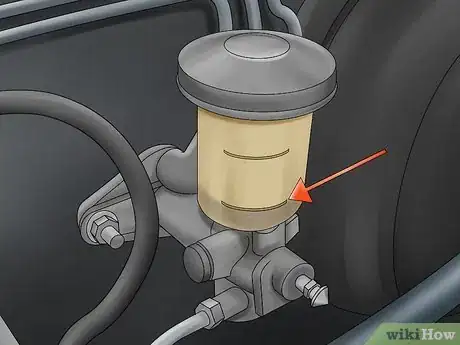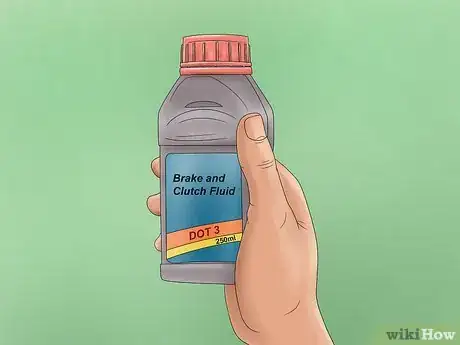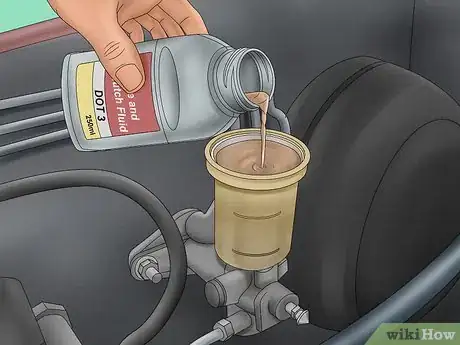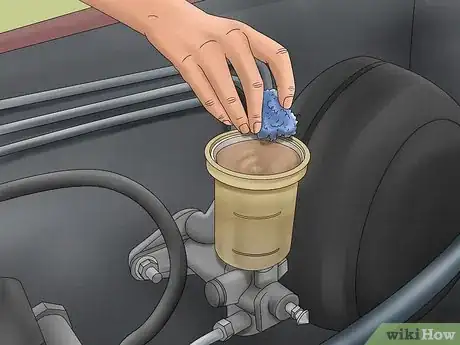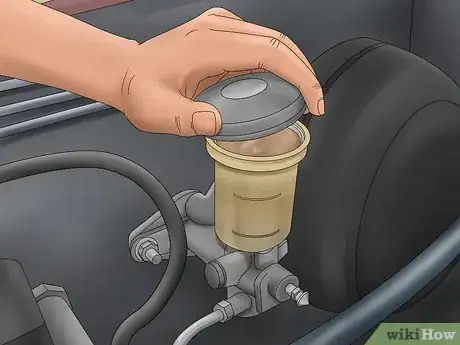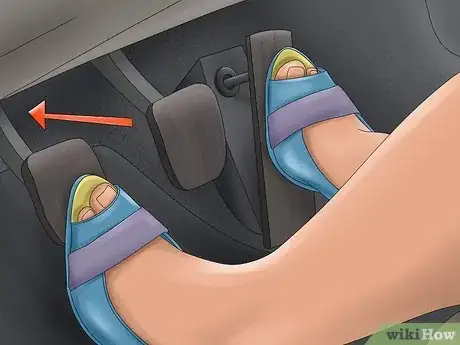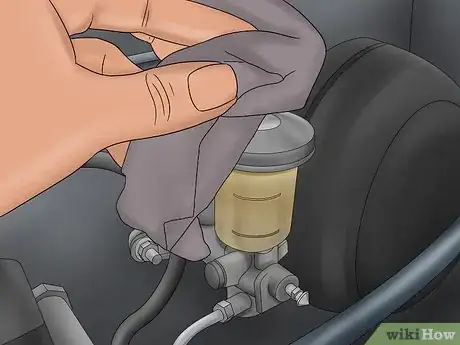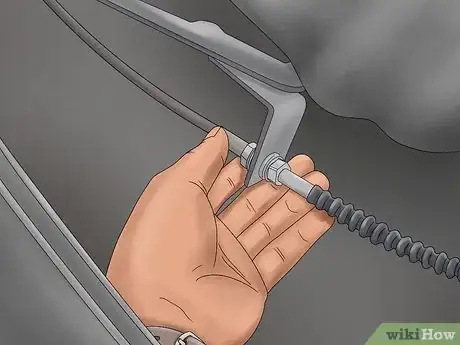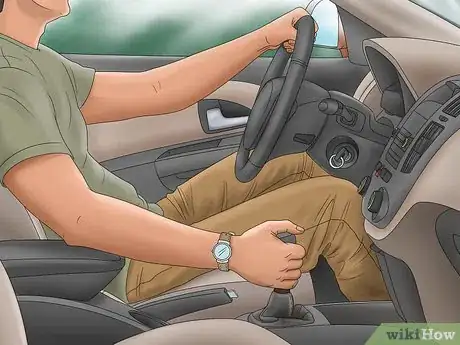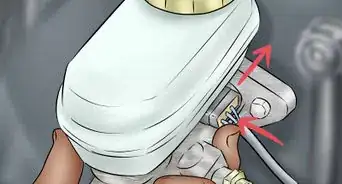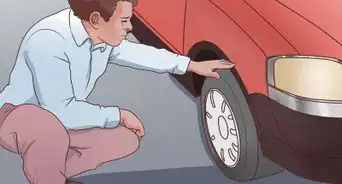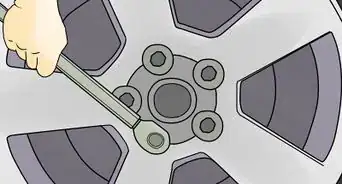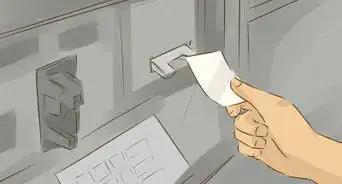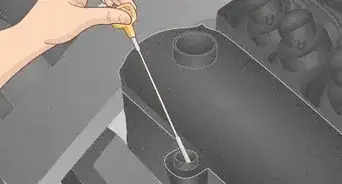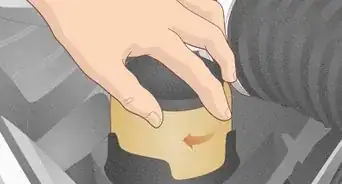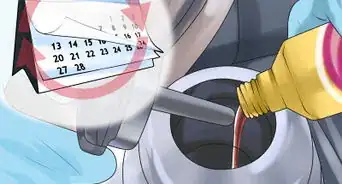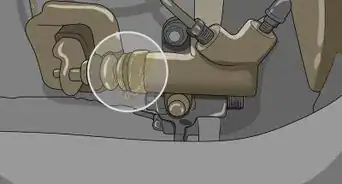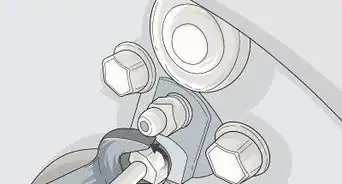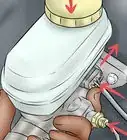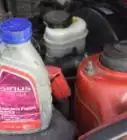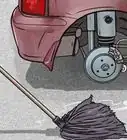This article was co-authored by Matthew Rava. Matthew Rava is an Auto Repair Expert and the Co-founder & Head of Marketing of Brakes to You. He specializes in auto repairs that concern brakes. Matthew earned a BS from West Chester University of Pennsylvania.
wikiHow marks an article as reader-approved once it receives enough positive feedback. In this case, several readers have written to tell us that this article was helpful to them, earning it our reader-approved status.
This article has been viewed 174,134 times.
In many of today's manual transmission automobiles, the clutch is engaged by using a hydraulic system that is almost identical to a hydraulic brake system. Hydraulic fluid that is contained within the master cylinder becomes pressurized when the clutch pedal is lowered. The pressurized fluid triggers the slave cylinder and disengages the clutch. If the fluid level in the clutch master cylinder runs low, the clutch may fail to engage and disengage properly. To maintain a properly functioning clutch, it is a good idea to check the clutch fluid level annually and to replace fluid as needed.
Steps
Checking Fluid Levels in a Clutch Master Cylinder
-
1Park your vehicle on level ground. In order to evaluate the level of brake fluid in the clutch master cylinder, it is important that your vehicle is level. Parking on a hill or at an angle can cause the level in the master cylinder reservoir to read incorrectly.[1]
- You may want to allow the vehicle to cool for an hour or two to prevent burning yourself when checking the fluid levels.
- Parking at an angle may make it appear that you have more or less brake fluid than you actually do.
-
2Open the hood. Find the hood release on the driver’s left hand side. It is usually located near the door frame with a small image of a car with its hood open. Pull the release back toward you to release the hood. Approach the vehicle from the front and pull the hood up slightly. It will catch on the safety release. Slip your hand beneath the hood and find the lever to release it.
- In some vehicles, the safety release is located in the grill rather than under the hood.
- If you are unable to locate the release, check in your vehicle’s owner’s manual for guidance.
Advertisement -
3Locate the clutch master cylinder. With the hood propped open, locate the clutch master cylinder. It is usually located on the firewall of the vehicle, just below the windshield. It will have a plastic reservoir that will be either clear or semi-clear with lines indicating the fluid level inside.
- If you are having difficulty locating the clutch master cylinder, refer to your vehicle’s service manual for assistance.
- The clutch master cylinder is usually on the driver’s side of the vehicle.
-
4Check the fluid level. Inspect the reservoir attached to the clutch master cylinder. There will be at least two lines indicating a minimum acceptable level of brake fluid and a maximum. If the brake fluid does not reach the “full” line, you should add fluid. If it is close or below the minimum line, you should inspect the master cylinder and clutch system for leaks.
- If the brake fluid is well below the minimum line, there may be a leak somewhere in the system.
- Leaks not only allow brake fluid to escape, but allow pockets of air to enter which can cause further issue when operating your clutch.
Filling the Clutch Master Cylinder
-
1Purchase the correct type of brake fluid for your vehicle. Most vehicles use one of three common types of brakes fluid. It is extremely important that you purchase the correct type of brake fluid for your clutch master cylinder to avoid doing damage to the system or preventing the clutch from engaging. Refer to your vehicle’s owner’s manual to identify what the specific type of brake fluid you need for your vehicle.[2]
- Most vehicle’s require SAE J1703, US FMVSS or 116 DOT 3 brake fluid in the clutch master cylinder.
- If you do not have a copy of the owner’s manual for your vehicle, look for the information you need on the automaker’s website.
-
2Add brake fluid until it reaches the “full” line on the reservoir. Poke a hole in the seal on the mouth of the brake fluid, then tear a larger hole on the opposite side. This will allow the brake fluid to pour from the container in a controlled and easily directed fashion. Open the reservoir attached to the clutch master cylinder and pour brake fluid in until it reaches the “full” line.[3]
- You can tear the seal off of the brake fluid container completely, but it will make it harder to direct your pour without spilling any.
- Be careful not to overfill the reservoir as it may cause the clutch to not function properly.
-
3Ensure no dirt or debris falls into the reservoir. Be aware of any dirt or debris that may fall into the clutch master cylinder while it’s open. Even a small amount of sediment can create significant problems for the clutch system. Blocked lines can prevent the clutch from engaging or create a buildup in pressure that can result in leaks.
- If anything falls into the brake fluid in the open master cylinder, try to scoop the debris out or dab at it with a dry cloth.
- Keep the lid on the clutch master cylinder reservoir at all times when not filling it.
-
4Inspect and replace the lid. Once the reservoir if full of brake fluid, inspect the lid for signs of damage before screwing it back on. If the threads on the lid are crossed or damaged, it may prevent a seal from occurring. A failed seal will allow air to enter the clutch lines, which will cause issues with the function of the clutch.
- If the lid is damaged, place it back on the reservoir and do not drive the vehicle until you purchase a replacement.
- Replacement lids can be found at your local auto parts store.
Diagnosing Issues with the Clutch Master Cylinder
-
1Check the pressure in the clutch pedal. Press and depress the clutch pedal with the vehicle running. Feel for inconsistency in the pressure required to do so. Varying levels of pressure are a good indicator that there are pockets of air in the clutch system. If there are any air pockets in the system, you will need to bleed the clutch to remove them.
- Pockets of air can cause the clutch to not engage or disengage properly.
- Air in the clutch lines can be a symptom of a leak, so be sure to check carefully for one.
-
2Look for signs of leaking on the clutch master cylinder. The clutch master cylinder should be dry and free of sticky grime or sludge. If it is covered in grime, clean it off with a rag and some brake cleaner to make it easier to identify signs of a leak. If the brake fluid in the reservoir was very low before filling it, there may be a leak.[4]
- Once you’ve cleaned the master cylinder, start the vehicle and have a friend press the clutch a few times.
- Look for signs of bubbles or fluid leaking from the master cylinder.
- Check the reservoir and master cylinder again after a few days to ensure there are no leaks.
-
3Check the lines and slave cylinder for signs of leaking. If you did not identify any signs of leaking on the master cylinder or the cap for the reservoir, follow the lines leaving the master cylinder all the way to the slave cylinder. Check the lines and slave cylinder for signs of leaking or bubbling fluid.[5]
- If you locate a leak, you should have it repaired immediately.
- After sealing a leak, you will need to bleed the clutch system.
-
4Assess whether the clutch disengages properly. Put the vehicle in first gear and depress the clutch pedal as you apply gas to begin moving forward. Press the clutch again and shift into second gear. If there are any issues with getting the vehicle into our out of gear, it could be a result of the clutch failing to engage and disengage. If you have difficulty getting the transmission into gear, take the vehicle to a service professional to be diagnosed.[6]
- A failed clutch will not allow you to put the vehicle in gear at all.
- Slight grinding between gears may be due to clutch pressure issues, but may also be caused by failing synchros within the transmission.
Community Q&A
-
QuestionI replaced my clutch master and slave cylinders a little over a month ago. Everything was fine until this past weekend when the clutch pedal went to the floor and did not return. I checked the cylinders -- no leaks. The fluid level had not moved or drained. What is going on?
 Community AnswerA guess: When an external seal goes bad, the cylinder leaks. When an internal seal goes bad, the fluid cycles internally and fails to transmit its power.
Community AnswerA guess: When an external seal goes bad, the cylinder leaks. When an internal seal goes bad, the fluid cycles internally and fails to transmit its power. -
QuestionCan I use power steering fluid in my clutch slave cylinder in an emergency?
 Community AnswerNo. Power steering fluid has a different viscosity than brake fluid and will not function properly within the clutch system. It may fail to adequately transfer the pressure needed to disengage and engage the clutch.
Community AnswerNo. Power steering fluid has a different viscosity than brake fluid and will not function properly within the clutch system. It may fail to adequately transfer the pressure needed to disengage and engage the clutch. -
QuestionCan I use DOT4 brake fluid in my 1993 Toyota clutch slave cylinder?
 Community AnswerYes, DOT4 but not DOT5. DOT3 and DOT4 are very similar, but DOT5 is totally different.
Community AnswerYes, DOT4 but not DOT5. DOT3 and DOT4 are very similar, but DOT5 is totally different.
References
- ↑ http://www.trustmymechanic.com/adding-brake-fluid-to-clutch-master-cylinder/
- ↑ http://www.trustmymechanic.com/adding-brake-fluid-to-clutch-master-cylinder/
- ↑ http://www.trustmymechanic.com/adding-brake-fluid-to-clutch-master-cylinder/
- ↑ http://www.howacarworks.com/transmission/checking-and-removing-a-clutch-master-cylinder
- ↑ http://www.howacarworks.com/transmission/checking-and-removing-a-clutch-master-cylinder
- ↑ http://www.howacarworks.com/transmission/checking-and-removing-a-clutch-master-cylinder
